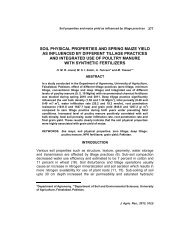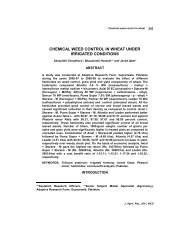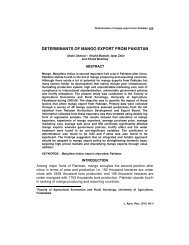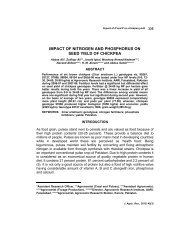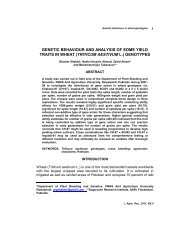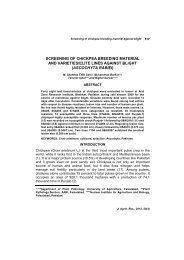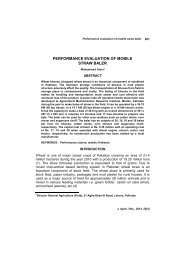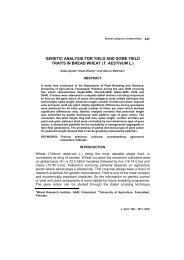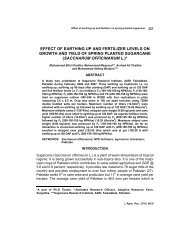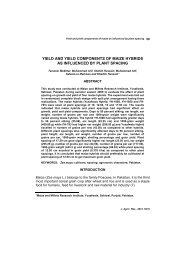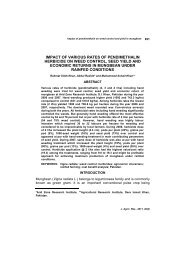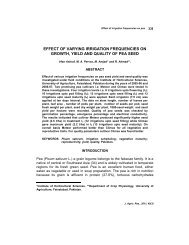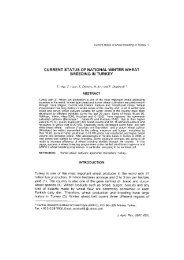comparison of bt and non-bt cotton (gossypium hirsutum l.)
comparison of bt and non-bt cotton (gossypium hirsutum l.)
comparison of bt and non-bt cotton (gossypium hirsutum l.)
- No tags were found...
You also want an ePaper? Increase the reach of your titles
YUMPU automatically turns print PDFs into web optimized ePapers that Google loves.
Comparison <strong>of</strong> Bt <strong>and</strong> <strong>non</strong>-Bt <strong>cotton</strong> cultivars for earliness indicators<br />
335<br />
COMPARISON OF BT AND NON-BT COTTON (GOSSYPIUM<br />
HIRSUTUM L.) CULTIVARS FOR EARLINESS INDICATORS AT<br />
DIFFERENT SOWING DATES AND NITROGEN LEVELS<br />
M. Sarwar, M. Farrukh Saleem, M. Ashfaq Wahid*, Amir Shakeel**<br />
<strong>and</strong> M. Faisal Bilal*<br />
ABSTRACT<br />
Bt <strong>and</strong> <strong>non</strong>-Bt <strong>cotton</strong> (Gossypium <strong>hirsutum</strong> L.) cultivars were compared for<br />
different earliness indicators in the Department <strong>of</strong> Agronomy, University <strong>of</strong><br />
Agriculture, Faisalabad, Pakistan during the year 2010. In this study two <strong>cotton</strong><br />
cultivars MNH-786 (<strong>non</strong>-Bt) <strong>and</strong> IR-1524 (Bt), three nitrogen levels (115, 145 <strong>and</strong><br />
175 kg/ha) <strong>and</strong> two sowing dates (mid March <strong>and</strong> mid May) were included.<br />
Layout system was RCBD with split split plot arrangement in a plot measuring<br />
6.0 x 4.5 m. Nitrogen levels <strong>and</strong> sowing dates showed significant effect on<br />
earliness related parameters. Nitrogen level <strong>of</strong> 115 kg per hectare showed more<br />
earliness index (59.2) than 145 kg (51.1) <strong>and</strong> 175 kg N (48.5). Nitrogen level <strong>of</strong><br />
115 kg also took less number <strong>of</strong> days for floral bud initiation (30.5), flowering<br />
(50.1), first boll splition (93.1) <strong>and</strong> also less number <strong>of</strong> days to node above<br />
white flower (95.9). With regards to sowing date, May sowing produced more<br />
earliness index (57.5) <strong>and</strong> less number <strong>of</strong> days for floral bud initiation (30.5),<br />
flowering (49.6), first boll splition (91.1) <strong>and</strong> less number <strong>of</strong> days to node above<br />
white flower (99.4) than mid March sowing. Both cultivars showed <strong>non</strong>significant<br />
differences in earliness related parameters with relatively more<br />
earliness in <strong>non</strong>-Bt cultivar than Bt cultivar. The study concludes that 115 kg N<br />
per hectare <strong>and</strong> mid May sowing produced early maturity in <strong>cotton</strong>.<br />
KEYWORDS: Gossypium <strong>hirsutum</strong>; Bt varieties; sowing; timing; nitrogen<br />
fertilizer; agronomic characters; Pakistan.<br />
INTRODUCTION<br />
After initiation <strong>of</strong> flowering in <strong>cotton</strong> (Gossypium <strong>hirsutum</strong> L.), vegetative<br />
growth continues due to its indeterminate <strong>and</strong> perennial habit but <strong>cotton</strong> is<br />
grown as an annual crop. Cotton plant has ability to overcome the fruit<br />
abscission <strong>and</strong> fruit damaging due to its growth <strong>and</strong> fruit pattern without yield<br />
reduction. However, it may increase the risk <strong>of</strong> insect attack <strong>and</strong> may also<br />
*Department <strong>of</strong> Agronomy, **Department <strong>of</strong> Plant Breeding <strong>and</strong> Genetics, University <strong>of</strong><br />
Agriculture, Faisalabad, Pakistan.<br />
J. Agric. Res., 2012, 50(3)
336<br />
M. Sarwar et al.<br />
delay the crop harvest. It indicates that yield recovery is only possible when<br />
the plant is young (23).<br />
Cotton growth <strong>and</strong> maturity are altered by cultivars, seasonal management<br />
<strong>and</strong> environmental conditions (11). Early maturity <strong>of</strong> <strong>cotton</strong> cultivars allows<br />
timely removal from the field, helps the crop to fit in double cropping system<br />
<strong>and</strong> can overcome the problem <strong>of</strong> water shortage (8, 24).<br />
Nitrogen is the integral part <strong>of</strong> chlorophyll, protein, nucleic acids,<br />
biomolecules, chromosomes <strong>and</strong> phytochromes (21, 22). Nutrients affect the<br />
photosynthesis, leaf area <strong>of</strong> the crop (6) <strong>and</strong> supply <strong>of</strong> carbohydrates to sink<br />
<strong>of</strong> the crop. To prevent the bolls <strong>and</strong> squares from abscission, nitrogen is<br />
important controlling factor (6, 27). Khan (20) observed that a mineral nutrient<br />
such as nitrogen is essential to attain higher yield <strong>of</strong> agricultural crops <strong>and</strong><br />
exploit the crop potential. Ahmad (1) reports that nitrogen is important<br />
nutrient for <strong>cotton</strong> yield in irrigated areas. In some other studies (3, 33)<br />
earliness reduced with increasing levels <strong>of</strong> nitrogen. High nitrogen availability<br />
caused excessive vegetative growth thus delaying crop maturity <strong>and</strong> reducing<br />
yield by shifting the balance between vegetative <strong>and</strong> reproductive growth<br />
(14).<br />
In early sown <strong>cotton</strong>, there is a serious reduction in yield because<br />
reproductive stages <strong>of</strong> the crop come in hottest months <strong>of</strong> the year. Crop<br />
sown in too early season has shown lower crop yield <strong>and</strong> lower crop st<strong>and</strong>,<br />
while crop sown in too late season <strong>of</strong> year resulted in excessive vegetative<br />
growth <strong>and</strong> reduction in yield. So for better crop management proper sowing<br />
time is the key factor in any region (34). The primary factor affecting crop<br />
development is temperature <strong>and</strong> initiation <strong>of</strong> first square <strong>and</strong> its development<br />
was temperature <strong>and</strong> cultivar dependant (13). Plant development rate is<br />
much increased at high temperature (15, 28, 29) shortening plant life period.<br />
Cotton earliness, a quantitative trait, is mainly affected by environment <strong>and</strong><br />
crop genotype (18). Therefore, in any cropping system cultivar selection is<br />
the key factor (25). Keeping in view the importance <strong>of</strong> earliness in <strong>cotton</strong> crop<br />
response <strong>of</strong> <strong>cotton</strong> crop to nitrogenous fertilizers <strong>and</strong> sowing dates, the<br />
present study was conducted to identify the cultivar that can fit well in our<br />
<strong>cotton</strong>-wheat cropping system.<br />
MATERIALS AND METHODS<br />
This study was conducted in the Department <strong>of</strong> Agronomy, University <strong>of</strong><br />
Agriculture, Faisalabad, Pakistan during kharif 2010. The soil <strong>of</strong> experimental<br />
site was s<strong>and</strong>y clay loam with alkaline pH (7.4), 0.65 percent organic matter,<br />
J. Agric. Res., 2012, 50(3)
Comparison <strong>of</strong> Bt <strong>and</strong> <strong>non</strong>-Bt <strong>cotton</strong> cultivars for earliness indicators<br />
337<br />
0.039 percent N, 7.85 ppm available phosphorus <strong>and</strong> 220 ppm available<br />
potassium. Layout-system was RCBD with split split arrangement replicated<br />
thrice. Plot size was 6x 4.5 m. Experimental treatments comprised three<br />
nitrogen levels viz. 115 kg (N 1 = recommended for <strong>non</strong>-Bt), 145 kg (N 2 =<br />
medium dose) <strong>and</strong> 175 kg per hectare (N 3 = recommended for Bt <strong>cotton</strong>),<br />
two sowing dates viz. mid March (S 1 = recommended for Bt) <strong>and</strong> mid May (S 2<br />
= recommended for <strong>non</strong>-Bt) <strong>and</strong> two <strong>cotton</strong> cultivars viz. MNH-786 (V 1 = <strong>non</strong>-<br />
Bt) <strong>and</strong> IR-1524 (V 2 = Bt).<br />
Each plot contained six rows <strong>of</strong> <strong>cotton</strong> crop. Seedbed was prepared by<br />
cultivating the field one time with rotavator <strong>and</strong> two times with tractormounted<br />
cultivator each followed by planking. The crop was sown on March<br />
14 <strong>and</strong> May 15, 2010 with help <strong>of</strong> dibbler by maintaining 0.75 m row to row<br />
<strong>and</strong> 0.30 m plant to plant spacings. Full dose <strong>of</strong> phosphorus was applied at<br />
sowing while nitrogen was applied in three equal splits viz. at sowing, 35 days<br />
after sowing (squaring stage) <strong>and</strong> 65 days after sowing (flowering stage).<br />
Crop was given nine irrigations throughout its growth period. Weeds were<br />
controlled by two hoeings viz. 35 <strong>and</strong> 65 days after planting while insects<br />
were controlled with insecticides. All other agronomic practices were kept<br />
normal <strong>and</strong> uniform for all treatments. When seedlings were established, ten<br />
true representative plants were selected r<strong>and</strong>omly from each plot. These<br />
plants were monitored <strong>and</strong> tagged to record the following data:<br />
Days from planting to first floral bud initiation<br />
Data on number <strong>of</strong> days from planting to first floral bud initiation [the days<br />
when su<strong>bt</strong>ending leaf unfolded (7)] were recorded from ten selected plants <strong>of</strong><br />
each plot, when bud beam became visible with the naked eye having a pin<br />
head size <strong>of</strong> about 3 mm.The data were recorded from the selected plants<br />
when 50 percent selected plants showed squaring.<br />
Days from planting to appearance <strong>of</strong> first flower<br />
Number <strong>of</strong> days from planting to appearance <strong>of</strong> first flower were noted when<br />
50 percent <strong>of</strong> selected plants showed flowering with creamy white or<br />
yellowish colour <strong>of</strong> flower.<br />
Days to node above white flower<br />
Data on this trait were recorded from selected plants after one week <strong>of</strong><br />
flowering <strong>and</strong> continued till appearance <strong>of</strong> five nodes above white flowers.<br />
Data were noted weekly in days <strong>and</strong> average <strong>of</strong> selected plants was<br />
calculated.<br />
J. Agric. Res., 2012, 50(3)
338<br />
M. Sarwar et al.<br />
Days from planting to first boll splition<br />
This parameter was noted when lint was seen within the boll with squares<br />
around (cracked boll) <strong>and</strong> took average <strong>of</strong> selected plants.<br />
Earliness index (%)<br />
Earliness index (%) was calculated with following formula (35).<br />
Earliness index (%) = Weight <strong>of</strong> seed <strong>cotton</strong> from first pick × 100<br />
Total seed <strong>cotton</strong> weight from all picks<br />
Growing degree days (DD 60°F)<br />
Minimum or base temperature for <strong>cotton</strong> growth is 60°F. Daily heat units or<br />
degree days (DD60s) as given in Table 1 were calculated as defined by<br />
Bendnarz <strong>and</strong> Burmester (5).<br />
Table 1.<br />
DD60 °F =<br />
Day time high °F + Night time low °F-60<br />
2<br />
Growing degree days (DD 60°F) during <strong>cotton</strong> growing period.<br />
S. March April May June July August September October November<br />
No.<br />
1 6.25 10.5 13.75 19.25 21.75 17.0 15.75 13.25 7.5<br />
2 6.5 11.5 18.25 21.5 24.25 16.0 16.25 13.5 8.5<br />
3 6.0 9.75 17.5 19.0 15.0 16.0 17.0 13.75 5.75<br />
4 1.75 12.5 19.75 17.5 18.0 15.75 16.75 13.5 5.75<br />
5 2.5 12.0 20.75 16.5 17.5 16.75 14.25 13.25 6.5<br />
6 4.0 11.25 11.25 15.25 15.5 16.0 15.5 13.25 5.75<br />
7 0.5 19.25 12.5 15.75 16.0 14.0 16.25 13.0 5.75<br />
8 2.5 22.75 13.5 14.25 17.75 15.5 15.25 13.0 5.0<br />
9 4.0 23.0 14.5 15.0 19.5 14.5 13.25 12.5 5.5<br />
10 5.25 23.0 16.0 15.0 20.75 16.0 12.75 12.5 4.5<br />
11 5.5 24.25 16.5 17.0 21.5 17.0 14.0 11.75 4.0<br />
12 6.0 24.25 15.5 18.25 15.0 13.5 14.0 12.0 4.0<br />
13 6.0 24.0 17.5 19.25 11.5 14.75 12.5 11.5 4.5<br />
14 7.25 23.5 15.0 19.25 14.25 16.25 13.0 11.5 3.5<br />
15 8.5 25.75 18.5 14.25 16.25 15.75 8.5.0 12.5 2.75<br />
16 8.75 17.75 18.5 15.5 19.0 14.0 12.25 13.0 2.25<br />
17 9.25 17.25 19.0 16.75 19.75 13.75 13.5 12.5 2.0<br />
18 9.5 18.5 17.5 18.0 18.5 16.25 10.0 11.75 2.5<br />
Table 1 contd…..<br />
J. Agric. Res., 2012, 50(3)
Comparison <strong>of</strong> Bt <strong>and</strong> <strong>non</strong>-Bt <strong>cotton</strong> cultivars for earliness indicators<br />
339<br />
19 9.5 16.75 14.5 20.5 17.75 16.5 9.5 12.5 2.0<br />
20 10.25 17.0 16.0 22.5 14.5 16.0 9.5 12.0 1.75<br />
21 11.5 15.0 16.5 22.5 10.25 15.65 12.75 11.25 1.25<br />
22 10.5 14.25 22.0 24.5 10.75 15.25 11.0 8.5 2.0<br />
23 12.5 11.5 22.75 21.75 12.0 16.25 13.25 6.0 1.0<br />
24 12.0 13.5 21.25 18.25 14.0 13.25 12.25 6.0 0.5<br />
25 11.25 14.5 20.75 17.75 16.0 13.5 12.0 6.5 0.75<br />
26 12.25 16.0 19.5 16.5 19.0 10.5 12.0 7.0 2.0<br />
27 11.5 16.0 24.25 20.5 17.0 10.75 11.75 6.0 1.0<br />
28 10.5 16.5 22.25 20.5 13.25 13.25 13.0 6.75 0.5<br />
29 11.5 16.25 15.5 22.0 12.75 14.25 12.5 7.0 0.5<br />
30 12.25 14.5 16.5 17.25 14.0 16.0 12.25 7.25 -0.25<br />
31 11.0 16.75 16.25 15.5 0.5<br />
Data collected on different parameters were analyzed statistically by using<br />
MSTAT-C (4) for analysis <strong>of</strong> variance. Means were separated using Fisher's<br />
protected least significant difference (LSD) test at 5 percent probability level<br />
(36).<br />
Days to first floral bud initiation<br />
RESULTS AND DISCUSSION<br />
The data (Table 2) indicated that this trait was significantly influenced by<br />
sowing dates <strong>and</strong> nitrogen levels while cultivars <strong>and</strong> all first order <strong>and</strong> second<br />
order interactions showed <strong>non</strong>-significant effects. Relatively less days to<br />
squaring were noted in <strong>non</strong>-Bt cultivar MNH-786 (32.9) than Bt cultivar IR-<br />
1524 (33.6) (Table 2). Mid March sowing took more days for floral bud<br />
initiation (36.0) than mid May sowing (30.5). These higher days to squaring in<br />
mid March sowing were due to low degree days accumulation in the months<br />
<strong>of</strong> March <strong>and</strong> April than mid May sowing. The primary factor affecting crop<br />
development is temperature as described by Hodges et al. (13). They also<br />
observed that initiation <strong>of</strong> first square <strong>and</strong> its development was temperature<br />
<strong>and</strong> cultivar dependant. They alongwith Reddy et al. (28, 29) further argued<br />
that plant development rate is much increased at high temperature<br />
shortening plant life period. Floral bud initiation <strong>and</strong> growth is affected by<br />
photoperiod (2). Initiation <strong>of</strong> squaring was used by Godoy (10) for the<br />
selection <strong>of</strong> early genotypes as against findings <strong>of</strong> Saleem et al. (32) which<br />
revealed that appearance <strong>of</strong> first floral bud cannot be used as an indicator to<br />
estimate earliness <strong>of</strong> <strong>cotton</strong> cultivars. Higher nitrogen level i.e 175 kg took<br />
more number <strong>of</strong> days for floral bud initiation (35.0) <strong>and</strong> was statistically<br />
J. Agric. Res., 2012, 50(3)
340<br />
M. Sarwar et al.<br />
Table 2.<br />
Effect <strong>of</strong> sowing date <strong>and</strong> nitrogen rates on earliness related traits <strong>of</strong><br />
<strong>cotton</strong> cultivars.<br />
Treatments DFS DFF NAWF DFOB EI<br />
Sowing dates<br />
Mid March (S 1) 36.0a 63.7a 108.3 110.4a 48.3<br />
Mid May (S 2) 30.5b 49.6b 99.4 91.1b 57.5<br />
LSD (p=0.05) 3.49 4.59 NS 14.24 NS<br />
Varieties<br />
MNH-786 (<strong>non</strong>-Bt) 32.9 55.5 102.7 99.6 55.0<br />
IR-1524 (Bt) 33.6 57.8 105.0 101.9 50.9<br />
LSD (p=0.05) NS NS NS NS NS<br />
N rates (kg/ha)<br />
115 30.5b 50.1b 95.9b 93.1b 59.2a<br />
145 34.2a 57.8a 106.8a 103.1a 51.1b<br />
175 35.0a 62.1a 108.9a 106.0a 48.5b<br />
LSD (p=0.05) 2.92 6.02 9.60 6.57<br />
Means not sharing a common letter within a column differ significantly at 5% probability level.<br />
NS= Non-significant, DFS= Days to first square, DFF= Days to first flower, NAWF= Node<br />
above white flower, DFOB= Days to first open boll, EI=Earliness index (%),<br />
similar to 145 kg N (34.2) (Table 2). Nitrogen level <strong>of</strong> 115 kg took minimum<br />
number <strong>of</strong> days to floral bud initiation (30.5). The regression analysis<br />
indicated that relationship between number <strong>of</strong> days to first floral bud initiation<br />
<strong>and</strong> node above white flower was strong <strong>and</strong> positive (R 2 = 0.79) (Fig. 1a).<br />
Similarly, linear regression coefficient (90 %) for number <strong>of</strong> days to first floral<br />
bud initiation vs earliness index was even more higher indicating strong but<br />
negative relationship (Fig 1b).<br />
J. Agric. Res., 2012, 50(3)
Comparison <strong>of</strong> Bt <strong>and</strong> <strong>non</strong>-Bt <strong>cotton</strong> cultivars for earliness indicators<br />
341<br />
Days to first flower<br />
The results (Table 2) further indicated that number <strong>of</strong> days to first flower were<br />
also affected by sowing dates <strong>and</strong> nitrogen levels significantly <strong>and</strong> by<br />
cultivars <strong>non</strong>-significantly. Relatively less days to first flower were taken by<br />
<strong>non</strong>-Bt cultivar MNH-786 (55.5) than Bt cultivar IR-1524 (57.8). Contrarily,<br />
Rehana et al. (30) observed significant difference in cultivars for number <strong>of</strong><br />
days taken to open first flower. A cultivar taking less number <strong>of</strong> days to<br />
flowering <strong>and</strong> first boll splition may be classified as earlier (9). Appearance <strong>of</strong><br />
first flower can be used as an indicator <strong>of</strong> early maturing cultivar (19). With<br />
regard to sowing dates, mid March sowing took more days to appearance <strong>of</strong><br />
first flower (63.7) than mid May sowing (49.6). These higher days to flowering<br />
in mid March sowing were due to low degree days accumulation in the<br />
months <strong>of</strong> March <strong>and</strong> April than mid May sowing (Table 1). The primary<br />
factor affecting crop development is temperature (13). Appearance <strong>of</strong> first<br />
flower was photoperiod dependant (17) <strong>and</strong> plant growth rates are highly<br />
correlated with temperature (38). The number <strong>of</strong> days from squaring to<br />
flowering, as well as the days from flowering to boll opening were influenced<br />
by temperature (12). Among N levels, 175 kg N took more number <strong>of</strong> days to<br />
appearance <strong>of</strong> first flower (62.1) <strong>and</strong> was statistically at par with 145 kg N<br />
(57.8). Relationship between number <strong>of</strong> days to appearance <strong>of</strong> first flower<br />
<strong>and</strong> node above white flower was strong <strong>and</strong> positive (R 2 = 0.75) (Fig 2a).<br />
Similarly its relation with earliness index was also strong <strong>and</strong> negative (R 2 =<br />
0.80) (Fig. 2b).<br />
J. Agric. Res., 2012, 50(3)
342<br />
M. Sarwar et al.<br />
Days to node above white flower (NAWF)<br />
This trait was significantly affected by nitrogen levels (Table 2) while sowing<br />
dates <strong>and</strong> cultivars had <strong>non</strong>-significant effect. Relatively less days to node<br />
above white flower were noted in mid May sowing (99.4) than in mid March<br />
sowing (108.4) Similiar <strong>non</strong>-Bt cultivar MNH-786 showed relatively less days<br />
to node above white flower (102.7) than Bt cultivar IR-1524 (105.0) (Table 2).<br />
Waddle (37) was the first to use node above white flower as an indicator <strong>of</strong><br />
maturity in <strong>cotton</strong>. He reported that varieties that attain five NAWF were the<br />
early maturing varieties. Nitrogen level <strong>of</strong> 175 kg took more days to node<br />
above white flower (108.9) <strong>and</strong> was statistically at par with 145 kg N (106.8).<br />
Nitrogen application after 175 kg did not respond indicating that high doses<br />
<strong>of</strong> nitrogen did not increase the flowering period, days to node above white<br />
flower <strong>and</strong> also seed <strong>cotton</strong> yield (16). Regression coefficient indicated that<br />
J. Agric. Res., 2012, 50(3)
Comparison <strong>of</strong> Bt <strong>and</strong> <strong>non</strong>-Bt <strong>cotton</strong> cultivars for earliness indicators<br />
343<br />
dependence <strong>of</strong> earliness index on days to node above white flower was 77<br />
percent which was strong <strong>and</strong> negative (Fig 3).<br />
Days to first boll splition<br />
Cultivars showed <strong>non</strong>-significant difference with respect to number <strong>of</strong> days<br />
from planting to first boll splition (Table 2). Panhwar et al. (26) observed that<br />
early maturing varieties opened their bolls earlier than late maturing varieties.<br />
Days to open first boll was used for selecting the early genotypes by Godoy<br />
(10). In contrast Rehana et al. (30) observed significant difference in cultivars<br />
for number <strong>of</strong> days taken to open first boll. Mid March sowing took more<br />
days to first boll splition (110.4) than mid May sowing (91.1). These higher<br />
days in mid March sowing were due to low degree days accumulation in the<br />
months <strong>of</strong> March <strong>and</strong> April than mid May sowing. Nitrogen rate <strong>of</strong> 175<br />
kg resulted in more number <strong>of</strong> days to first boll splition (106.0) <strong>and</strong> was<br />
J. Agric. Res., 2012, 50(3)
344<br />
M. Sarwar et al.<br />
statistically similar to 145 kg N (103.1). Relationship between number <strong>of</strong> days<br />
from planting to first boll splition <strong>and</strong> node above white flower was strong <strong>and</strong><br />
positive (R 2 = 0.69) (Fig. 4a). R 2 for number <strong>of</strong> days from planting to first boll<br />
splition vs earliness index was even higher (87 %) but negative (Fig. 4b).<br />
Earliness index (%)<br />
Earliness index was affected by nitrogen levels while sowing dates, cultivars<br />
<strong>and</strong> all interactions showed <strong>non</strong>-significant effect (Table 2). Nitrogen level <strong>of</strong><br />
115 kg showed significantly higher earliness index (59.2%) than 145 kg<br />
(51.1%) <strong>and</strong> 175 kg N (48.5%). It indicated that increased N level increased<br />
vegetative growth <strong>and</strong> delayed earliness. Similar results have also been<br />
reported by earlier scientists (3, 33). Percentage <strong>of</strong> first picking in the multiple<br />
harvests is a poor estimate <strong>of</strong> earliness (31).<br />
CONCLUSION<br />
It is concluded that mid May sowing <strong>and</strong> 115 kg nitrogen per hectare resulted<br />
in more earliness. Cultivars showed <strong>non</strong>-significant effect on earliness related<br />
parameters with relatively more earliness in <strong>non</strong>-Bt cultivar.<br />
REFERENCES<br />
1. Ahmad, N. 2000. Fertilizer scenario in Pakistan policies <strong>and</strong><br />
development. Proc. Con. Agri. Fert. Use. 2010 NFDC, P&D Division,<br />
Government <strong>of</strong> Pakistan Islamabad.<br />
J. Agric. Res., 2012, 50(3)
Comparison <strong>of</strong> Bt <strong>and</strong> <strong>non</strong>-Bt <strong>cotton</strong> cultivars for earliness indicators<br />
345<br />
2. Aitken, Y. 1974. Flowering Time, Climate <strong>and</strong> Genotype. Melbourne<br />
Univ. Press.<br />
3. Ali, S. A. <strong>and</strong> A. E. El-Sayed. 2001. Effect <strong>of</strong> sowing dates <strong>and</strong> nitrogen<br />
levels on growth, earliness <strong>and</strong> yield <strong>of</strong> Egyptian <strong>cotton</strong> cultivar Giza 88.<br />
Egypt. J. Agric. Res. 79: 221-232.<br />
4. A<strong>non</strong>. 1986. MSTATC. Microcomputer Statistical Programme. Michigan<br />
State University, Michigan, Lansing, USA.<br />
5. Bendnarz, R. C. <strong>and</strong> C. Burmester. 2007. Growth <strong>and</strong> Development –<br />
First 60 Days. Cotton Phy. Today. 13(2): 1.<br />
6. Borowski, E. 2001. The effect <strong>of</strong> nitrogenous compounds on the growth,<br />
photosynthesis <strong>and</strong> phosphorus uptake <strong>of</strong> sunflowers. Annals<br />
Universitatis Mariae Curie- Sklodowska. Sectio EEE, Horticultura. 9: 23-<br />
31.<br />
7. Constable, G. A. 1991. Mapping the production <strong>and</strong> survival <strong>of</strong> fruit on<br />
field-grown <strong>cotton</strong>. Agron. J. 83: 374-378.<br />
8. Faircloth, J. C. 2007. Planting. In: Virginia Cotton Production Guide.<br />
Publ. 424-300. Faircloth, J.C. (ed.). p. 4. Virginia Polytechnic Institute<br />
<strong>and</strong> State University Coop. Ext. Service, Blacksburg, VA.<br />
9. Godoy, A. S. <strong>and</strong> G. A. Palomo. 1999. Genetic analysis <strong>of</strong> earliness in<br />
upl<strong>and</strong> <strong>cotton</strong> (Gossypium <strong>hirsutum</strong> L.). II. Yield <strong>and</strong> lint percentage.<br />
Euphytica. 105: 161-166.<br />
10. Godoy, S. 1994. Comparative study <strong>of</strong> earliness estimators in <strong>cotton</strong><br />
(Gossypium <strong>hirsutum</strong> L.). Red de Fibras-Algodon, CIFAP-Laguna-<br />
INIFAP, Apdo, Postal 247, Torreon, Mexico. EA-Production-Vegetal. 90<br />
(3): 175-186.<br />
11. Gwathmey, C. O. <strong>and</strong> C. C. Craig Jr. 2003. Managing earliness in<br />
<strong>cotton</strong> with mepiquat-type growth regulators. Crop Manag.<br />
doi:10.1094/CM-2003-1222-0 1 -RS [Accessed 12.11.2010].<br />
12. Hesketh, J. D. <strong>and</strong> A. Low. 1968. Effect <strong>of</strong> temperature on components<br />
<strong>of</strong> yield <strong>and</strong> fibre quality <strong>of</strong> <strong>cotton</strong> varieties <strong>of</strong> diverse origin. Cott. Gr.<br />
Rev. 45: 243-257.<br />
13. Hodges, H. F., K. R. Reddy, J. M. McKinion <strong>and</strong> V.R. Reddy. 1993.<br />
Temperature effects on <strong>cotton</strong>. Mississippi Agric. For. Exp. Sta. Bull.,<br />
990, Mississippi State, MS.<br />
14. Howard, D. D., C. O. Gwathmey, M. E. Essington, R. K. Roberts <strong>and</strong> M.<br />
D. Mullen. 2001. Nitrogen fertilization <strong>of</strong> no till <strong>cotton</strong> on loess-derived<br />
soils. Agron. J. 9 (3):157-163.<br />
15. Iqbal, M., M. A. Chang, M. Abid, M. Z. Iqbal, M. Hassan <strong>and</strong> N. I. Khan.<br />
2003. Maturity <strong>of</strong> <strong>cotton</strong> cultivars in Multan as determined by nodes<br />
above white flower. Asian J. Pl. Sci. 2: 325-330.<br />
J. Agric. Res., 2012, 50(3)
346<br />
M. Sarwar et al.<br />
16. Iqbal, M., M. A. Chang, M. Z. Iqbal <strong>and</strong> M. Hassan. 2003. Effect <strong>of</strong><br />
nitrogen on maturity <strong>of</strong> <strong>cotton</strong> by using node above white flower. Pak. J.<br />
Biol. Sci. 6(21): 1845-1848.<br />
17. Jones, P. G. <strong>and</strong> D. R. Laing. 1978. Simulation <strong>of</strong> the phenology <strong>of</strong><br />
soybeans. Agric. Systems. 3: 295-311.<br />
18. Kassianenko, V. A., V. A. Dragavtsev, G. I. Razorenov <strong>and</strong> T. S.<br />
Razorenov. 2003. Variability <strong>of</strong> <strong>cotton</strong> (Gossypium <strong>hirsutum</strong> L.) with<br />
regard to earliness. Genet. Resour. Crop Evol. 50: 157-163.<br />
19. Khan, M. A., A. S. Larik <strong>and</strong> Z. A. Soomro. 2002. Study <strong>of</strong> gene action<br />
for yield <strong>and</strong> yield components in G. <strong>hirsutum</strong> L. Asian J. Pl. Sci. 1: 130-<br />
131.<br />
20. Khan, N. A. 1996. Response <strong>of</strong> mustard to ethrel spray <strong>and</strong> basal <strong>and</strong><br />
foliar application <strong>of</strong> nitrogen. J. Agron. Crop Sci. 175: 331-334.<br />
21. Marschner, H. 1986. Minerals nutrition <strong>of</strong> higher plants. Academic Press<br />
Inc. San. Diego. USA. p. 148-173.<br />
22. Mengel, K. <strong>and</strong> E. A. Kirkby. 1987. Principles <strong>of</strong> Plant Nutrition. 4lh<br />
Edition. International Potash Institute, Bern.<br />
23. Montez, G. H. <strong>and</strong> P. B. Goodell. 1994. Yield compensation in <strong>cotton</strong><br />
with early season square loss. Proc. Belt. Cotton Conf., National Cotton<br />
Council, Memphis TN. p. 916-919.<br />
24. Neil, F. 1991. Strategies for provision <strong>of</strong> development pesticide<br />
resistance. Proc. ICAC- CCRI Reg. Consultation on Insect Resistance<br />
Management in Cotton. June 28- July 1.<br />
25. Nichols, S. P., C. E. Snipes <strong>and</strong> M. A. Jones. 2004. Cotton growth, lint<br />
yield <strong>and</strong> fibre quality as affected by row spacing <strong>and</strong> cultivar. J. Cotton<br />
Sci: 8: 1-12.<br />
26. Panhwar, G. N., A. R. Soomro, R. Anjum, S. B. Babar, A. M. Memon<br />
<strong>and</strong> A.W. Soomro. 2002. Predicting earliness in <strong>cotton</strong> during crop<br />
development stage-11. Asian J. Pl. Sci. 1: 37-38.<br />
27. Perumai, N. K. 1999. Effect <strong>of</strong> different nitrogen levels on morphophysiological<br />
characters <strong>and</strong> yield in rainfed <strong>cotton</strong>. India. J. Pl. Physiol.<br />
4: 65-67.<br />
28. Reddy, K. R., H. F. Hodges <strong>and</strong> J. M. McKinion. 1997a. A <strong>comparison</strong><br />
<strong>of</strong> scenarios for the effect <strong>of</strong> global climate change on <strong>cotton</strong> growth<br />
<strong>and</strong> yield. Aust. J. Pl. Physiol. 24: 707-713.<br />
29. Reddy, K. R., H. F. Hodges <strong>and</strong> J. M. McKinion. 1997b. Crop modeling<br />
<strong>and</strong> applications: A <strong>cotton</strong> example. Adv. Agron. 59: 225-290.<br />
30. Rehana, A., A. R. Soomro <strong>and</strong> M. A. Chang. 2001. Measurement <strong>of</strong><br />
earliness in upl<strong>and</strong> <strong>cotton</strong>. Pak. J. Biol. Sci. 4: 462-463.<br />
31. Richmond, T. R. <strong>and</strong> L. L. Ray. 1966. Product quantity measures <strong>of</strong><br />
earliness <strong>of</strong> crop maturity in <strong>cotton</strong>. Crop Sci. 6: 235-239.<br />
J. Agric. Res., 2012, 50(3)
Comparison <strong>of</strong> Bt <strong>and</strong> <strong>non</strong>-Bt <strong>cotton</strong> cultivars for earliness indicators<br />
347<br />
32. Saleem, M. F., S. A. Anjum, A. Shakeel, M. Y. Ashraf <strong>and</strong> H. Z. Khan.<br />
2009. Effect <strong>of</strong> row spacing on earliness <strong>and</strong> yield in <strong>cotton</strong>. Pak. J. Bot.<br />
41(5): 2179-2188.<br />
33. Sawan, Z. M., M. H. Mahmoud <strong>and</strong> O. A. Momtaz. 2006. Agronomy <strong>and</strong><br />
soils response <strong>of</strong> yield, yield components, <strong>and</strong> fibre properties <strong>of</strong><br />
Egyptian <strong>cotton</strong> (Gossypium barbadense L.) to nitrogen fertilization <strong>and</strong><br />
foliar-applied potassium <strong>and</strong> mepiquat chloride. J. Cotton Sci. 10: 224-<br />
234.<br />
34. Sekloka, E., J. Lancon, E. Goze, B. Hau, S. L. Dhainaut <strong>and</strong> G.<br />
Thomas. 2008. Breeding new <strong>cotton</strong> varieties to fit the diversity <strong>of</strong><br />
cropping conditions in Africa: Effect <strong>of</strong> plant architecture, earliness <strong>and</strong><br />
effective flowering time on late-planted <strong>cotton</strong> productivity. Expl. Agri.<br />
44: 197-207.<br />
35. Singh, P. 2004. Cotton Breeding. Kalyani Publishers, Ludhiana, New<br />
Delhi Noida (U. P.) Hyderabad Chennai Kolkata Cuttack India. p: 118-<br />
295.<br />
36. Steel, R. G. D., J. H. Torrie <strong>and</strong> D. A. Dickey. 1997. Principles <strong>and</strong><br />
Procedures <strong>of</strong> Statistics: A Biometrical Approach. 3 rd Ed. McGraw Hill<br />
Book Co. Inc. New York. p: 400-428.<br />
37. Waddle, B. A. 1974. Using mid summer measurements as earliness<br />
indicators. Proc. Beltwide Cotton Prod. Res. Conf., Dallas, TX. p. 78-79<br />
7-9 Jan. 1974. Natl. Cotton Counc. Amer., Memphis, TN.<br />
38. Wanjura, D. F. <strong>and</strong> J. R. Supak. 1985. Temperature methods for<br />
monitoring <strong>cotton</strong> development. Proc. Beltwide Cotton Conf. New<br />
Orleans, LA. p. 369-372. 6-11 Jan. 1985. Brown, J. <strong>and</strong> T.C. Nelson<br />
(eds.). Natl. Cotton Council, Memphis, TN.<br />
J. Agric. Res., 2012, 50(3)



